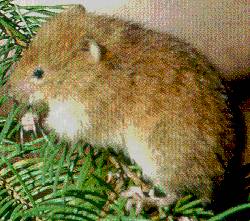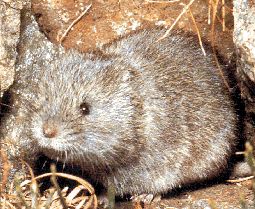
The Arvicolinae are a subfamily of rodents that includes the voles, lemmings, and muskrats. They are most closely related to the other subfamilies in the Cricetidae. Some authorities place the subfamily Arvicolinae in the family Muridae along with all other members of the superfamily Muroidea. Some refer to the subfamily as the Microtinae or rank the taxon as a full family, the Arvicolidae.

Microtus is a genus of voles found in North America, Europe and northern Asia. The genus name refers to the small ears of these animals. They are stout rodents with short ears, legs and tails. They eat green vegetation such as grasses and sedges in summer, and grains, seeds, root and bark at other times. The genus is also called "meadow voles".

Clethrionomys is a genus of small, slender voles. In recent years the genus name was changed to Myodes, however a 2019 paper found that Myodes was actually a junior synonym for Lemmus, thus making it unusable. As such, Clethrionomys is re-established as the proper genus name. At the same time, several species were moved to the genus Craseomys, so members of both genera are referred to as red-backed voles. This genus was described by Johannes von Nepomuk Franz Xaver Gistel under the pseudonym "G. Tilesius". Some authors cite the taxonomic authority as "Gistel, 1850", whereas others still use "Tilesius, 1850".

The genus Arborimus is a group of voles found in western North America. The genus name is Latin for "tree mouse". Some sources include this genus with the heather voles, genus Phenacomys, and both are classified in the tribe Phenacomyini.

Water voles are large voles in the genus Arvicola. They are found in both aquatic and dry habitat through Europe and much of northern Asia. A water vole found in Western North America was historically considered a member of this genus, but has been shown to be more closely related to members of the genus Microtus. Head and body lengths are 12–22 cm, tail lengths are 6.5–12.5 cm, and their weights are 70–250 g. The animals may exhibit indeterminate growth. They are thick-furred and have hairy fringes on their feet that improve their swimming ability.

The royal vole, also called the Korean red-backed vole, is a species of vole endemic to the Korean Peninsula. It lives underground in a burrow, emerging at night to feed on grasses, seeds and other vegetation. The International Union for Conservation of Nature has listed its conservation status as being of "least concern".

The grey red-backed vole or the grey-sided vole is a species of vole. An adult grey red-backed vole weighs 20-50 grams. This species ranges across northern Eurasia, including northern China, the northern Korean Peninsula, and the islands of Sakhalin and Hokkaidō. It is larger and longer-legged than the northern red-backed vole, which covers a similar range and it is also sympatric with the Norwegian lemming.

Alticola is a genus of rodent in the family Cricetidae.

Chionomys is a genus of rodent in the family Cricetidae.
The Hokkaido red-backed vole is a species of rodent in the family Cricetidae. It is found at high altitudes on the island of Hokkaido in Japan and at lower altitudes on some smaller islands nearby. Its natural habitat is temperate forests.
The Chinese scrub vole, or Irene's mountain vole, is a species of rodent in the family Cricetidae. It is endemic to mountainous parts of southern China and is very similar to the Sikkim mountain vole in appearance. The International Union for Conservation of Nature has assessed its conservation status as being of "least concern".
The juniper vole is a species of rodent in the family Cricetidae. It is found in Afghanistan, China, Pakistan and Tajikistan. It was formerly classified in the genus Neodon, but genetic evidence indicates that it is classified within the subgenus Blanfordimys in Microtus.

Blyth's vole is a species of rodent in the family Cricetidae. It was previously the only species in the genus Phaiomys, but was moved to Neodon in 2016. It is found in mountainous regions in northern India, Nepal and China. It is a burrowing rodent and lives in small colonies. It has a wide distribution and faces no particular threats so the International Union for Conservation of Nature has assessed its conservation status as being of "least concern".
The Sikkim mountain vole is a species of rodent in the family Cricetidae. It is found in Bhutan, India, Nepal and China.
The Duke of Bedford's vole is a species of rodent in the family Cricetidae. After the Liangshan vole was removed from this genus, the Duke of Bedford's vole became the only member of the genus Proedromys. It is found only in mountainous parts of central China. It is a rare species and the International Union for Conservation of Nature has assessed its conservation status as being "vulnerable".
The Clethrionomyini are a tribe of forest voles in the subfamily Arvicolinae. This tribe was formerly known as Myodini, but when genus Myodes was deemed to be a junior synonym, the tribe was renamed. Species in this tribe are:

Arvicolini is a tribe of voles in the subfamily Arvicolinae.

Alexandromys is a genus of voles in the subfamily Arvicolinae, formerly a subgenus of the genus Microtus. Species in this genus are:

Microtini is a tribe of voles in the subfamily Arvicolinae.
The Nepalese mountain vole is a species of rodent in the family Cricetidae. It is found only in Nepal.




















